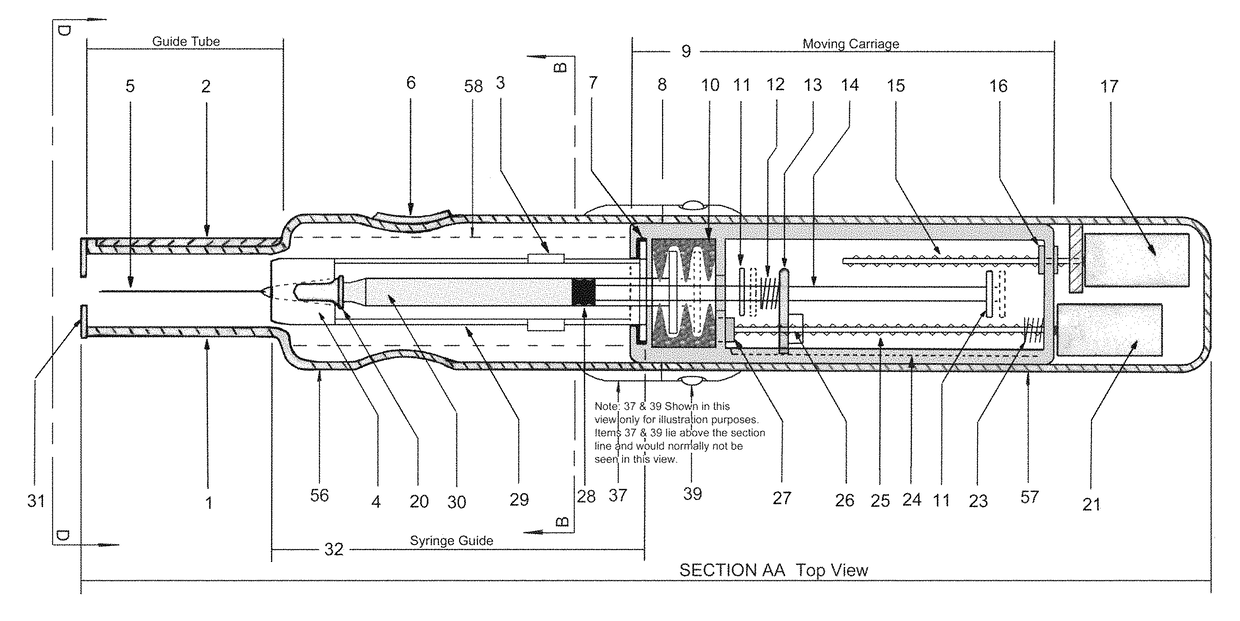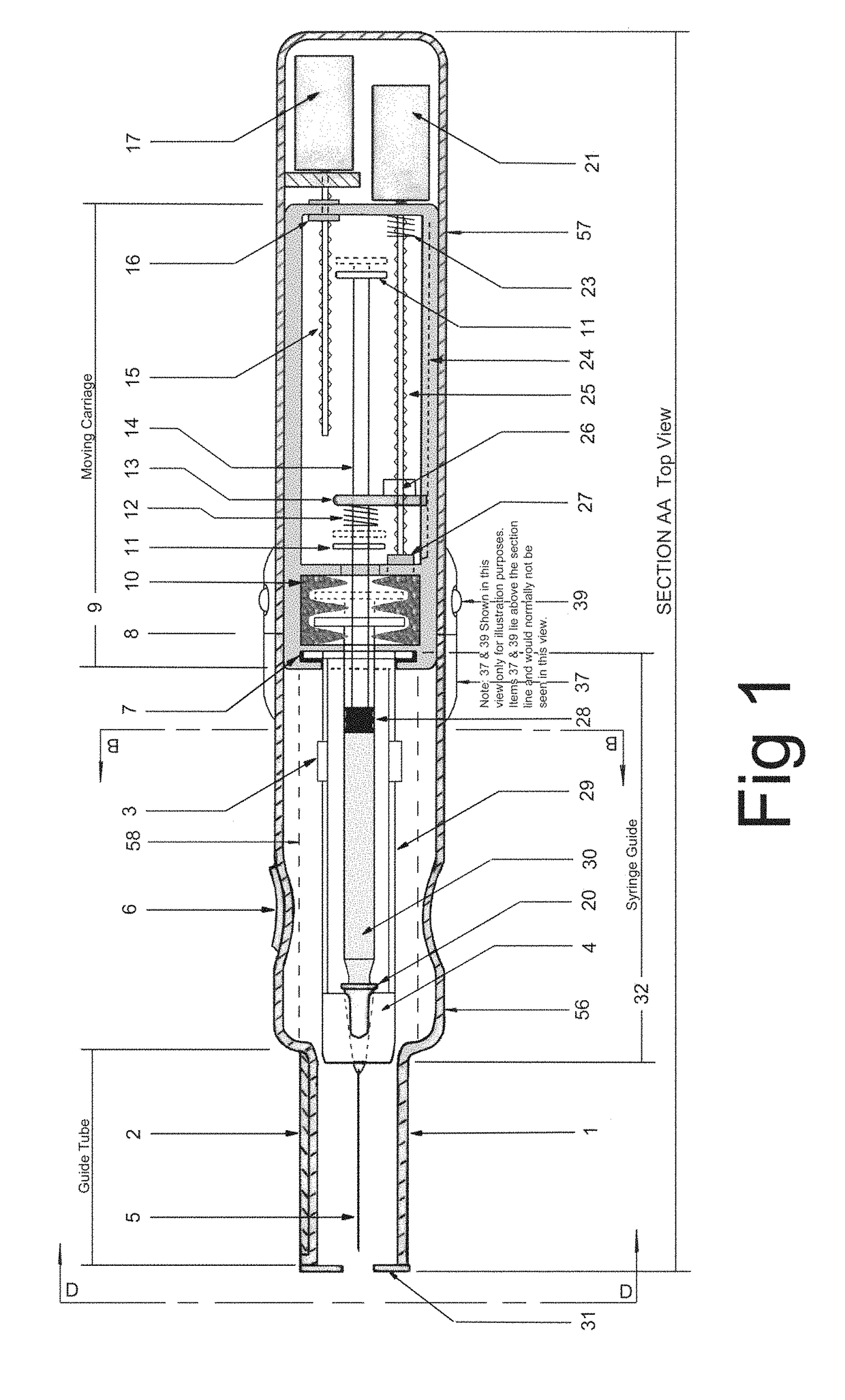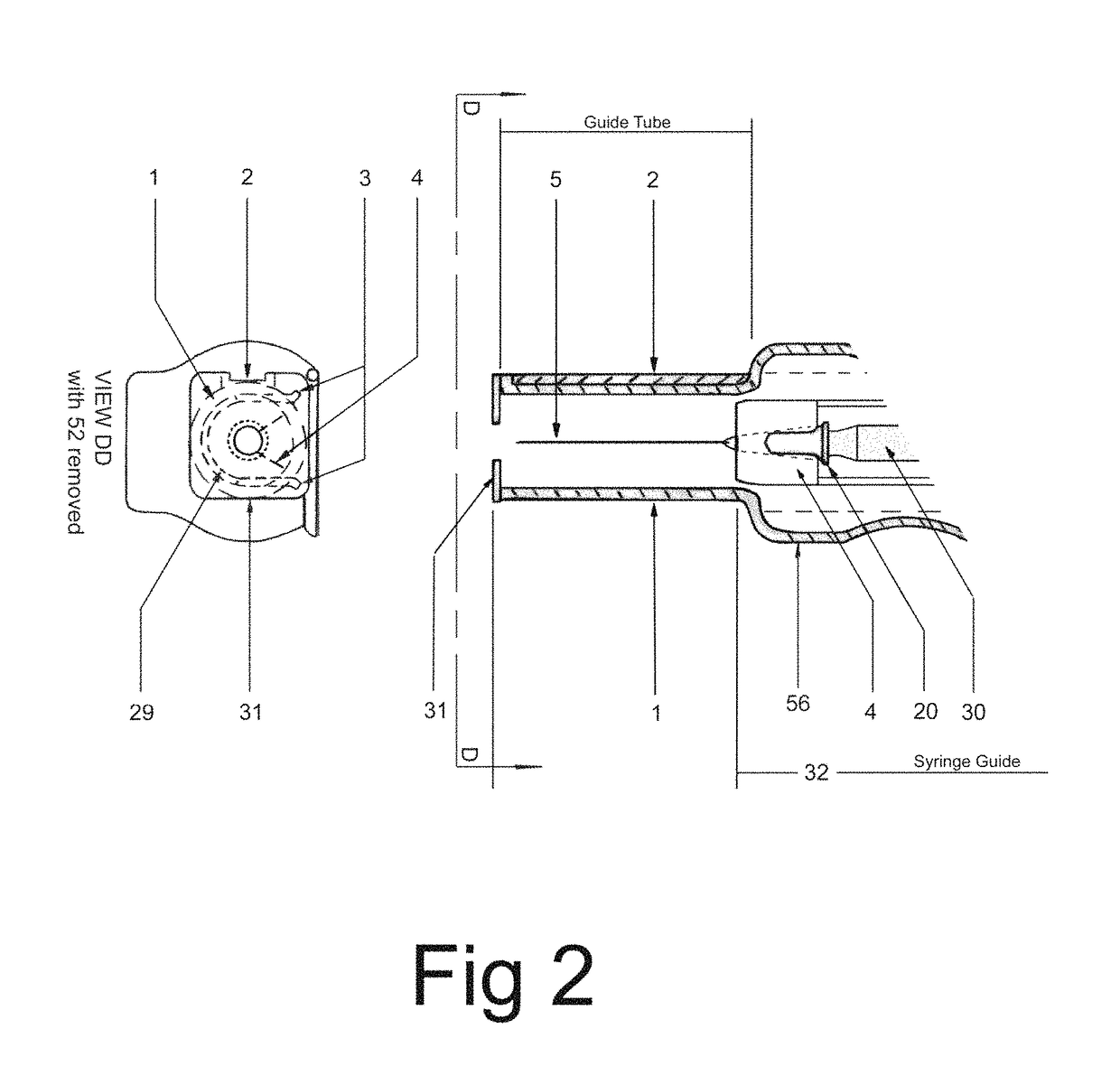In an aspect, a medication delivering
injector which includes a housing having opposing proximal and distal ends and an accessible
internal cavity for inserting and removing a medicament container such as a
syringe. The
injector is designed to hold and manipulate a medication delivery device such as a large variety of standard and non-standard medical syringes with fixed or attached needles, assembled such that centrally located is a cylinder containing a liquid medicament and attached either permanently or removably to the distal end of the cylinder, is a
hypodermic needle or cannula in fluidic communication with the cylinder. The needle can be from one-half inches to one-and-one-half inches in length in the illustrated embodiment and other sizes are possible by changes in scale of the
injector. At the proximal end of the cylinder is an opening with an inserted seal or
bung with an attached rod thus constituting a
plunger. The central medicament containing cylinder could also be a standard medicament
cartridge. Hereinafter, both are referred to as a “
syringe”. A lid or access cover which, in an open position permits
insertion and removal of the
syringe into / from the housing in a horizontal fashion thus providing ease of loading. The syringe is inserted with the needle end toward the distal end of the housing and the
plunger toward the proximal end of the housing. A movable
carriage is disposed in the proximal end of the housing and slides in the axial direction forwards and rearwards such that a syringe, whose proximal end is gripped by the
carriage, so moves with the
carriage such that the needle exits the housing at the distal end of the housing and pierces the tissue of the patient prior to dispensing of the medicament, and then is retracted after the medicament has been dispensed by retraction of the carriage. Attached to the carriage is an
actuator which pushes on the syringe
plunger causing the medicament contained within the syringe cylinder to be dispensed through the needle into the patient's tissue. In one embodiment suitable for both removable needle and fixed needle syringes, the proximal end of the syringe including the syringe finger
flange is gripped by an elastomeric
flange grip which resides within the carriage, while the syringe distal end resides in and is supported by a “syringe guide” which is attached to the carriage and thus moved with it. In another embodiment which is so made to accommodate syringes with removable needles and their safe disposal, the syringe
flange at the proximal end of the cylinder is gripped by an elastomeric flange grip which resides in the carriage as described above, while the syringe distal end is supported by a needle which resides in a removable
disposable needle shield. The
needle guide is biased toward the carriage and thus, the syringe body is compressed and guided as the carriage moves forward and rearward.Both the movement of the carriage and the
actuator are controlled by
servo motors which are controlled by
electronics and a
microcontroller so operating such that speeds and accelerations are controlled smoothly and gently so as to avoid the stop / start motion of motors controlled by limit switches and simple
electronics or the vibration and abruptness such as result from injectors powered by compressed springs or gas. Furthermore, the forces are adaptive to the loads imposed and the requirements necessary for the proper dispensation of medicaments with high
viscosity or sensitivity to shear forces.The housing, approximately midway between proximal and distal ends, is affixed by a hinge such that the device can be folded in half to provide for a more compact device to be stored and transported.On the distal end of the housing are electrical sensor pads in communication with the
microcontroller such that contact with the patient's
skin and the angle at which the injector is held against the
skin and the steadiness with which the injector is being held can be ascertained. Within the housing are a haptic vibrator and an audio speaker, both producing a vibration which is variable in
pitch in such a manner that
biofeedback is provided to the injector user as to the pressure, angle and steadiness with which they are holding the injector against the
skin. This facilitates the action of injection oneself in the gluteus
muscle where
visual feedback isn't available to the patient.Multiplexed onto the electrical sensor pads, is a TENS (
Transcutaneous Electrical Nerve Stimulation) generator which is operational (at the user's choice) just before and during the injection to interrupt or quench the pain of tissue perforation often accompanied with needle injections.Contained on the surface of the housing such as on the access cover, is a display such that user menus, device state, directions, and
battery charge status, etc. are displayed. Also contained on the surface of the housing, on the proximal half, are buttons which control the menus and selections that are shown on the display. These selections provide for the user to set such parameters as hypodermic
insertion speed and medicament dispensing speeds, the preferred mode of user
biofeedback which can include: speech mode (which can be accompanied by musical themes and ringtones, plus variable
pitch tone and haptic vibration), MP3 mode (which has speech muted but includes musical ringtones and variable
pitch tone and haptic vibration), and haptic mode (which is haptic vibration and audio tone queues needed for injector position
biofeedback and readiness), plus mute mode (which provides no audio but the haptic vibration remains), and none, which provides no vibrational biofeedback, yet the display information always remains available.Also contained on the surface of the housing on the distal half, is an “injection initiate” button which causes the sequences required for performance of an injection to occur if said button is “enabled”.Contained within the
electronics and its operating program is the ability to audibly play pre-recorded human speech in any language such that: directions in the form of consecutive steps which are required to load the medicament container (syringe) into the device, consecutive steps to perform an injection, steps to remove and properly dispose of parts, to alert of
device status and menu choices, etc. can be played through the audio speaker. Also contained within the electronics and program is the ability to play musical ringtones as a
distraction during the
needle insertion and injection or when a scheduled injection alarm is reached, or calming human voice exhibiting bedside manner during the
needle insertion and injection.Also contained within the electronics and
software is a real-time
clock-calendar which can store a patient's injection schedule and play a musical ringtone as an alarm as each scheduled injection becomes due. Also contained within the electronics and
software are the ability to communicate with a
personal computer through a
USB port, which can also charge the injector's rechargeable battery. The battery in one embodiment, consists of three AAA batteries which can be rechargeable or non-rechargeable. The
USB port in combination with an application running on the
personal computer, is used to download the injection schedule into the real-time
clock-calendar and to download ringtones and musical themes of the user's choice and to download foreign language sets for the pre-recorded
human language feature.The injector can be further equipped with the capability to aspirate the tissue by drawing back on the plunger thus creating a vacuum into which fluids will flow. These fluids enter the syringe cylinder where they can be checked for the presence of blood by optical absorption in the red spectrum. This information is useful in the instances where intramuscular injections are to be given with drugs whose ‘Full
Prescribing Information’ instructs the patient to aspirate and check for blood in the syringe which indicates that the puncture of a
vein has occurred, and if so detected, to abort the injection and then re-inject into a different location.
 Login to View More
Login to View More  Login to View More
Login to View More 


